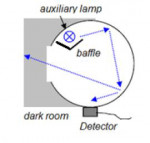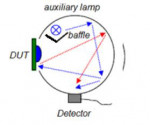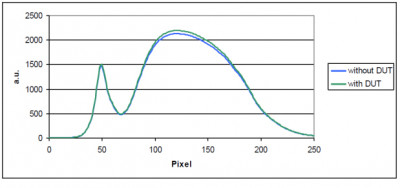6.3 Self-Absorption Correction with an Integrating Sphere
Self-absorption correction is applied in measurements using integrating spheres in order to adapt the measured data sets to the device under test (DUT) or in other words, in order to take the DUT’s influence during the measurement into account. The DUT blocks an open port of an integrating sphere to a certain extent thus causing a back reflection into the sphere and hence an additional signal within the sphere. This adds to the signal of the DUT and falsifies the measured value. This is the case for both spectral and integral measurements. Such kind of an error can be compensated via the so-called selfabsorption correction where an additional auxiliary lamp is needed. This shows that for accurate integrating sphere measurements often individuall integrating spheres with auxiliary lamp, custimzed meausrement port for specific DUT configrations, etc. are needed.
An integrating sphere is typically calibrated to match the geometry of an “open sphere” or an “empty sphere”. An open sphere enables light of a DUT or an internal supporting lamp to exit the integrating sphere through inter-reflection (compare Fig. 1).

Fig. 1: Open sphere, light can exit the sphere
In case of the application, the measurement port is either blocked partially or fully with the DUT or the DUT is situated within the sphere; in both cases, the sphere is called “filled sphere” in both cases (Fig. 2). A part of the light that would exit in case of an open sphere is now reflected back into the sphere thereby increasing the signal. If the DUT is placed in the sphere, a part of the light is absorbed by the DUT’s casing and does not contribute to the inter-reflection anymore, thus reducing the signal. The magnitude of the induced inter-reflection or the absorption error depends on the composition of the DUT and the way it is mounted. If for example the DUT is mounted to the outside of the sphere, is somehow large when compared to the port size and if it is strongly reflective, the induced error is going to be larger than in the case of a smaller absorbing DUT. If on the other hand, the DUT is placed within the sphere and if it is strongly reflective the induced error is going to be smaller than in case of a strongly absorbing DUT.

Fig. 2: Closed sphere, a part of the light is inter-reflected
The caused discrepancies can be compensated via a self-absorption correction factor (Fig. 3). Here, the signal of the empty (open) sphere as well as the signal with the DUT attached to or placed within the (filled) sphere is measured. The differing measured intensities are used to determine a correction factor which represents the relation of both measured values. This compensation is performed for an integral detector or for a spectral array. Since the correction factors depend on the geometry as well as the spectral reflection of the DUT, the determined correction factors can be used for all light source of the same constructional type, e. g. for LEDs of the same type – assuming the measurement geometry remains unchanged.

Fig. 3: Measurement of a LED (DUT) with and without the self-absorption correction of the DUT
See also integrated standard products like the BTS256-LED Tester and an Integrating Spheres with more details.